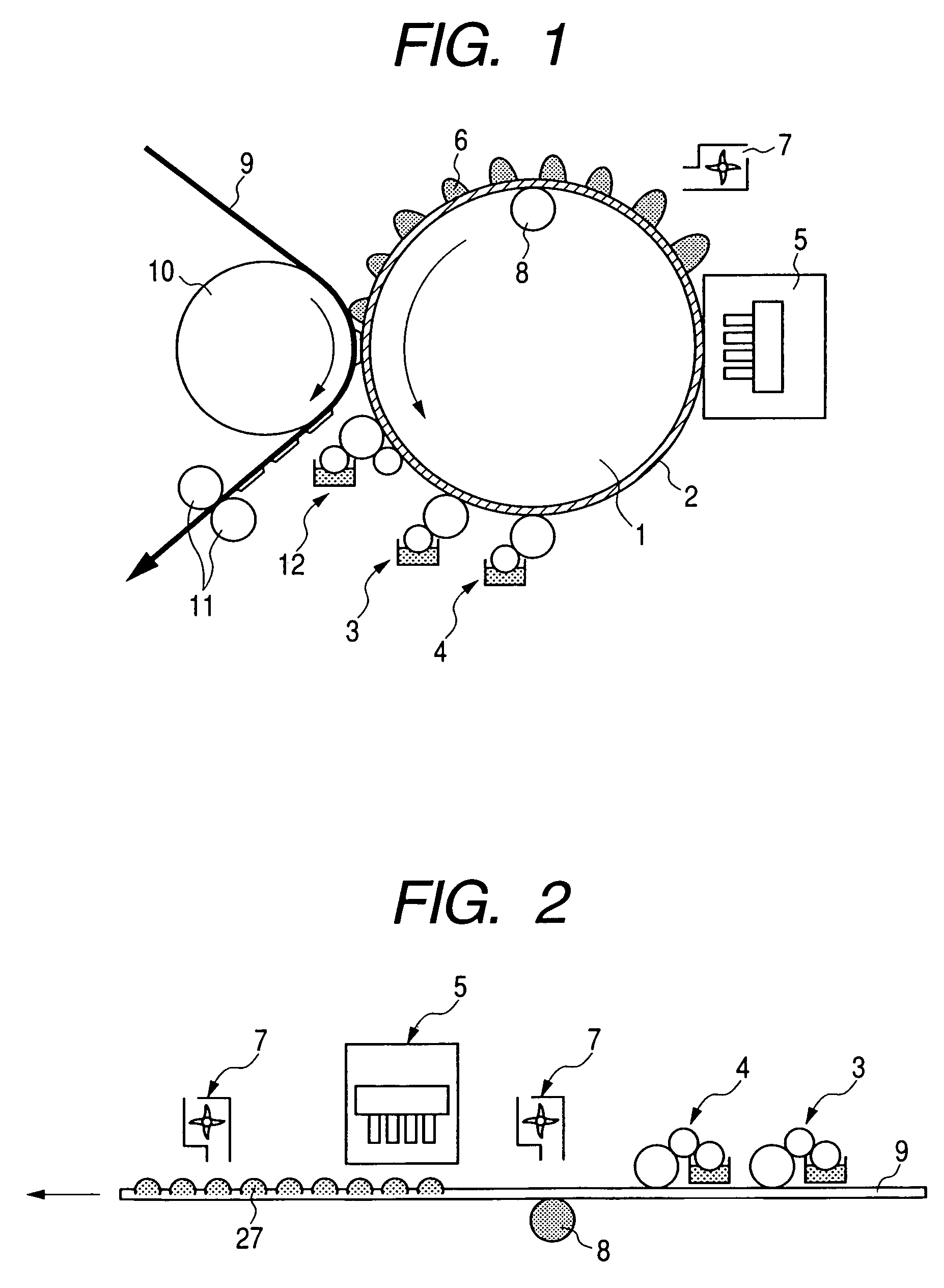Image forming process and image forming apparatus
a technology of image forming and forming process, which is applied in electrographic process, instruments, other domestic objects, etc., can solve the problems of high plate cost to the individual prints, comparatively high price, and low production bas
- Summary
- Abstract
- Description
- Claims
- Application Information
AI Technical Summary
Benefits of technology
Problems solved by technology
Method used
Image
Examples
first embodiment
[0051]The feature of the first embodiment of the present invention is first briefly described before this embodiment described in detail. The feature of the first embodiment resides in that a first material (wettability-improving component) for improving the wettability of the surface of an intermediate transfer medium is applied to the intermediate transfer medium before the application of a second material (image-fixing component) for lowering the flowability of an ink on the intermediate transfer medium for the purpose of permitting uniform application of the second material to the intermediate transfer medium or holding of the second material applied to the intermediate transfer medium at a desired position. By applying this first material, the image-fixing component is prevented from being repelled on the intermediate transfer medium, and so the beading of the image-fixing component does not occur. Therefore, the image-fixing component can be uniformly applied to the intermedia...
example 1
[0095]An image-recording system of this example will hereinafter be described by steps.
(a) Application of Wettability-Improving Component:
[0096]In this example, an aluminum drum coated with a silicone rubber (KE12, trade name, product of Shinetsu Kagaku Co., Ltd.) having a rubber hardness of 40° in a thickness of 0.5 mm was used as the intermediate transfer medium. A fluorocarbon type surfactant (FTERGENT FT-400, trade name, product of NEOS Company Limited) was first applied to the surface of the intermediate transfer medium by a roll coater.
(b) Application of Image-Fixing Component:
[0097]A 10% aqueous solution of aluminum chloride hexahydrate was then applied by a roll coater.
(c) Formation of Ink Image:
[0098]A character image mirror-reversed was formed on the intermediate transfer medium, to the surface of which the above components had been applied in Steps (a) and (b), by means of an ink-jet recording apparatus (nozzle density: 1200 dpi; ejection quantity: 4 pl; drive frequency: ...
example 2
[0101]An image-recording system of this example will hereinafter be described by steps.
(a) Application of Wettability-Improving Component:
[0102]In this example, an aluminum drum coated with a silicone rubber (KE30, trade name, product of Shinetsu Kagaku Co., Ltd.) having a rubber hardness of 60° in a thickness of 0.5 mm was used as the intermediate transfer medium. A fluorocarbon type surfactant (SURFLON S-141, trade name, product of SEIMI CHEMICAL Co. Ltd.) was first applied to the surface of the intermediate transfer medium by a roll coater.
(b) Application of Image-Fixing Component:
[0103]The following aqueous solution was then applied by a roll coater.
[0104]
Calcium chloride dihydrate10 partsFluorocarbon type surfactant 1 part(SURFLON S-141, trade name, productof SEIMI CHEMICAL Co. Ltd.)Crosslinking agent (Carbodilite V-02, 1 partTrade name, product of NisshinboCo. Ltd.)Ion-exchanged water88 parts.
(c) Formation of Ink Image:
[0105]A character image mirror-reversed was formed with fo...
PUM
| Property | Measurement | Unit |
|---|---|---|
| contact angle | aaaaa | aaaaa |
| critical surface tension | aaaaa | aaaaa |
| thickness | aaaaa | aaaaa |
Abstract
Description
Claims
Application Information
 Login to View More
Login to View More - R&D
- Intellectual Property
- Life Sciences
- Materials
- Tech Scout
- Unparalleled Data Quality
- Higher Quality Content
- 60% Fewer Hallucinations
Browse by: Latest US Patents, China's latest patents, Technical Efficacy Thesaurus, Application Domain, Technology Topic, Popular Technical Reports.
© 2025 PatSnap. All rights reserved.Legal|Privacy policy|Modern Slavery Act Transparency Statement|Sitemap|About US| Contact US: help@patsnap.com


